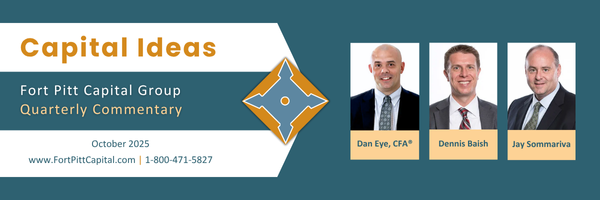Investment Newsletter Third Quarter 2025

A New Chapter Begins in Early 2026
Beginning early 2026, we will officially become Focus Partners Wealth. This transition reflects our commitment to delivering a more powerful, client-centric experience—unlocking deeper expertise, broader capabilities, and enhanced resources—all while preserving the boutique feel and personalized attention you’ve come to value.
As part of this transition, this will be the final edition of the Fort Pitt Capital Group Market View – Investment Newsletter. There will be a brief pause in content as we prepare for our new format. Beginning Wednesday, February 4, 2026, you’ll start receiving two refreshed monthly emails from focuspartnerswealth@email.focuspartners.com designed to keep you informed and connected.
- Focused Insights: Our monthly newsletter features timely market outlooks, wealth management strategies, expanded services, economic updates, advanced planning insights, and more.
- Monthly Events and Webinars Email: A curated roundup of upcoming investment-focused webinars, lifestyle resources, and events tailored to support you and those close to you.
We understand that change can bring questions. Please know that while the format and branding may look different, our commitment to delivering thoughtful, relevant content remains unchanged.
If you have any questions, we’re here for you.
Resiliency
Major U.S. equity indices added to substantial gains from the prior quarter, registering multiple all-time highs along the way. The S&P 500 Index advanced by 8.1% in Q3, with the technology sector leading the charge again. Stocks leveraged to the “AI” (Artificial Intelligence) theme were the big winners, with semiconductor, semiconductor equipment, and cloud computing stocks providing a strong boost to equity index returns. International stocks also turned in a solid result with the MSCI ACWI ex-U.S. Index advancing by 6.9%.
Fixed income markets performed well as interest rates drifted lower in anticipation of rate cuts from the Federal Reserve built throughout the quarter. Those expectations were ultimately fulfilled as the Fed reduced short-term interest rates by 0.25% in September. Short and intermediate maturity bond indices posted low single-digit returns and are on track to deliver respectable returns for 2025.
Economic growth and consumer spending have continued to show strength, while deterioration in the labor market has given the Federal Reserve the green light to start lowering interest rates. The final reading on second-quarter gross domestic product (GDP) clocked in at an impressive 3.8% growth rate, and the Federal Reserve Bank of Atlanta is currently estimating a similar outcome for the current quarter. Inflation readings have remained above the Fed’s 2% target but have not shown evidence of the tariff-related price spikes that economists predicted earlier in the year. However, labor demand has clearly weakened with job additions well below expectations and June’s revised nonfarm payroll report marking the first time since the pandemic that the economy actually lost jobs. Investors have accepted the weakening labor market as a necessary precursor to commencing the interest rate easing cycle. History suggests that this is likely the correct approach. According to JPMorgan data, the Fed has lowered interest rates with equity markets within 1% of record highs 16 times in the past, which has been followed by an average return of nearly 15% over the next year.
Corporate earnings results have been another supportive contributor to equity market returns. In aggregate, S&P 500 companies posted significantly better-than-expected year-over-year earnings growth of +10 % in the second quarter, and expectations are for ~8% growth in the third quarter. Additionally, corporate profit margins have held up well and are comfortably above the five-year average level. We view this as supportive of our view that management teams have been well-prepared to navigate the tariff situation and are pulling numerous levers to successfully mitigate its impact.
As always, risks and concerns remain – including elevated valuations among the AI darlings, the potential for re-escalation of trade disputes/tariffs, and a more substantial weakening in the labor market, among others. However, we’ve been impressed with the resiliency of the economy, financial markets, and corporate earnings results over the past six months. The outcome has certainly been more positive than the one priced in by equity markets back in early April when indices plunged into bear market territory. Investors often overlook and underestimate the resiliency factor in the midst of market turmoil, an attribute that becomes visible only after the storm has passed.
Fort Pitt Capital Group (FPCG) is an investment advisor registered with the United States Securities and Exchange Commission (“SEC”). For a detailed discussion of FPCG and its services and fees, see the Form ADV Part 1 and 2A on file with the SEC at www.adviserinfo.sec.gov. Registration with the SEC does not imply any level of skill or training. You may also visit our website at www.fortpittcapital.com.
Any opinions expressed are opinions held at the time of publishing and are subject to change. It does not constitute an offer, solicitation, or recommendation to purchase any security. The information herein was obtained from various sources; we do not guarantee its accuracy or completeness. Past performance does not guarantee future results. The performance shown is for illustrative purposes only and the intent is to show the performance of certain segments of the markets. This information is not reflective of the performance of any FPCG client, or the impact of security selection on actual client portfolios. Actual results and developments may be substantially different from the expectations described in the forward-looking statements included herein.

